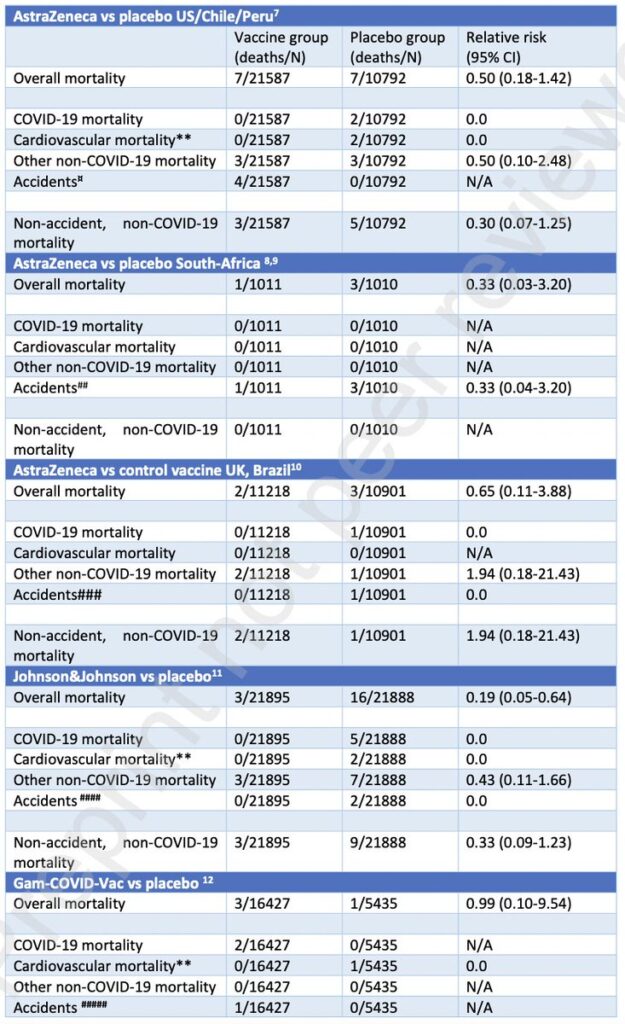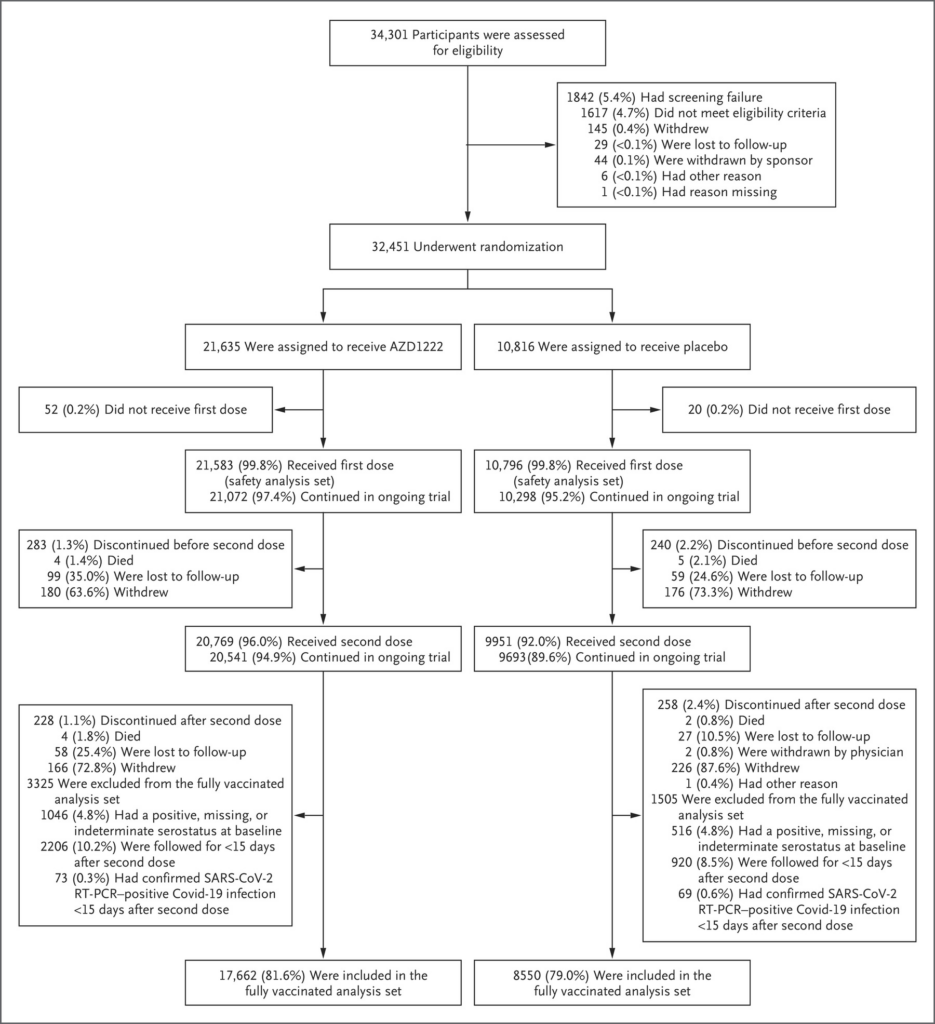There’s been a lot of excitement recently about a Danish study published as a pre-print in the Lancet that analysed trial data and claimed to find adenovirus-vector Covid vaccines such as AstraZeneca (AZ) and Johnson and Johnson (J&J) reduced overall mortality by around 63% and cardiovascular mortality in particular by around 99%. The study authors note it appears these vaccines “provide significant protection” against cardiovascular disease, and speculate this may be because the adenovirus vector, though not able to replicate, “may prime the immune system in a way similar to a ‘live’ vaccine”. How this might protect against cardiovascular disease is not explained.
The study has been reported at sceptical sites such as the Brownstone Institute, TCW Defending Freedom and Bad Cattitude. Each asks whether people have been given the “wrong vaccine”, in that while the trial data for the mRNA vaccines (Pfizer and Moderna) did not show any mortality benefit, those for the adenovirus vaccines showed considerable and, importantly, statistically significant benefit.

I reported on the study earlier in the month, expressing scepticism about the supposed benefits of the adenovirus-vector vaccines for non-Covid mortality.
Medical student Santiago Sanchez has criticised the claims of the study and its commentators on Twitter in a thread that is unnecessarily laced with vitriol but nonetheless makes some helpful points amidst the bile. In particular he notes that almost all the favourable mortality data come from one trial, the J&J one, where nine people in the placebo arm died from non-Covid, non-accident causes versus just three in the vaccine arm (see below).
Indeed, the placebo arm in this trial seems to have been oddly death-prone, with 16 versus three deaths overall, including two versus zero accidents, two versus zero cardiovascular deaths and seven versus three deaths from other causes. Interestingly, the AstraZeneca vaccine trial in the U.S. had an accident-prone vaccine arm, with four versus zero accident deaths, illustrating how these small numbers are very susceptible to freak random occurrences. The same U.S. trial also had two versus zero cardiovascular deaths, while the Sputnik (Gam-COVID-Vac) trial had one versus zero cardiovascular deaths, to give the five versus zero cardiovascular deaths (out of around 50,000 and 72,000 participants respectively) in adenovirus-vector vaccine trials overall that raise the possibility of causation and the vaccines somehow curing heart disease.


Notably, the death rate overall in the adenovirus-vector vaccine trials was considerably lower than in the mRNA vaccine trials (377 vs 822 deaths per million overall, 600 vs 809 per million in just the control arms). This is likely a reflection of the lower age profile of participants in the adenovirus-vector vaccine trials – though this wouldn’t explain the lower proportion of deaths in the vaccine arms versus the control arms.
Perhaps the most significant difference between the two types of trial is in the follow-up time, with the J&J trial follow-up after the single dose being around half that of the mRNA trials after the second dose – and the mRNA trials also had the four week period between the doses.

In the U.S. AZ trial, a massive 10.2% of participants in the vaccine arm (2,206) were followed up for less than 15 days after the second dose (see below). How many of them were lost to follow-up because they died but this was not identified, and how many died subsequently without their death being recorded? It’s worth noting the number lost in the vaccine arm was considerably more than the 8.5% (920) followed up for less than 15 days in the placebo arm.

Santiago Sanchez notes:
If you follow people for longer, more people will die of more causes, by chance. If you look at one group followed over a longer period versus another in a shorter period, you can’t interpret mortality differences between those groups.
Sanchez has also spotted that the recently published final results for the J&J trial are now available and include a longer follow-up time of around four months. By this point the odds ratio (OR) of non-Covid death in the vaccine arm rises to 0.7-1.18 (95% confidence interval), reflecting a between 30% drop and 18% rise, which is not statistically significant. (The final trial data don’t include an update on causes of death so we don’t know how many were cardiovascular.)
Based on this, it seems most unlikely that the adenovirus-vector vaccines really reduce non-Covid mortality or cure heart disease. Much more likely these were random events, assisted by short and possibly weak follow-up.
While adenovirus-vector vaccines may not be as bad for the heart as mRNA vaccines, they have been found to cause some serious and deadly blood clotting issues. More data on vaccines and mortality are needed, but in the meantime it would be advisable to proceed on the basis that any apparent association between the Covid vaccines and improved heart health or reduced non-Covid mortality is coincidental.














To join in with the discussion please make a donation to The Daily Sceptic.
Profanity and abuse will be removed and may lead to a permanent ban.
Stoopid is as stoopid does…
They’d rather go broke than admit their utopian ideas exist only in their heads.
Indeed. Morons. They deserve to go bankrupt.
I do feel sorry for the small businesses in the close area, who played no part in this woke utopia.
I agree.
Can’t stop laughing
Hahahahahahah.
“A ‘woke’ theatre in Paris known for its radical Leftist shows faces bankruptcy …”
Oh dear, never mind.
Well at least some good will come from this. Not exactly a loss to “art” although the loss of the next door bistro is nigh on criminal as a result of the actions of these firkers.
‘Academics from top universities’ More like complete and utter simpletons. Who pays these people? Really?
Funded by taxpayers probably.
The government should DO something!
Oh, hold on. Paris’s Socialist-led council is the government.
Don’t worry though. The theatre won’t go bust. The Conseil de Paris will stump up some cash somehow and will still get voted in again next election. It’s a PR system so they can’t be ousted by any right-of-centre party.
It must be a really good performance if they refuse to leave.
Bis!
I believe the production was called
A comedy of errors.
It’s Waiting for Godot. They’re still waiting.
You’d need a heart of stone not to laugh.
“They sit around smoking joints”. Where do they get the money to buy them?
WHERE do they get them, plus food or did they bring in months of supplies with them? Turn the water supply off to the building and I reckon they’d likely move out after a day or so
Woke idea meets reality, exhibit number 17283.
Yup. “I repeatedly kicked a concrete wall, and now my foot hurts!”.
Yeah but the concrete wall won’t do that again – whatever it was.
The analogy with the situation at a country level would be complete if the theatre was running a clown show.
Perfect.
Or run by the Marx Brothers!
Tant pis.
Théâtre de l’absurde, mes amis.
Oh the folly. Cheered me up no end


They’re being frightened away by all these young men.
Same as usual – just men of fighting age.
When stupid, pompous, bien pensant ideas meet reality. Hilarious.
You’d have to have a heart of stone not to laugh!
Theatre of the absurd
That’s not a very gracious attitude. You get a free show and then you take over the building. I wouldn’t put up with something like that I mean I would deal with the sheer effrontery and brass neck very harshly. If you haven’t got the balls to do that then you aren’t a man. And it wouldn’t even be difficult for them to make an example of these miscreants.
It’s good to see Evil Leftists Get Their Comeuppance!
“Reinventing the welcome for refugees in France.”
Oh the irony!
Tres amusant
Stupid communist females. I presume their biological psychology kickes in when they saw these strapping, forceful, manly Africans, and they started flirting with them.
These low IQ natives are a danger to us all. What did they expect…..oh yes, they still think all the worlds people’s are just like white, higher IQ Europeans. When are they going to learn?
Kick out all Africans and Indians, Pakistanis and many middle easterners, and any other persons feom themed would countries. They are almost always trouble, and the majority of them are on welfare and in housing paid for by the hard earned taxes of white Europeans. Time to accept reality as it smacks you in the face. Facts are uncomfortable and often emotionally imlactful – it proves you wrong.
Where is there any mention of females, communist or otherwise?
Not all women are dangly-earring-wearing socialists or beardy-weirdos.
Get back in your shed until you think of a helpful and legal way to get authorities to end this uncontrolled migration nightmare.
Being played out on a grander scale in any country near you.
Probably it’s a waiting room until their UK dinghy’s are ready
Go woke, go broke.
Well done you lefty morons.
You’d need a heart of stone not to laugh